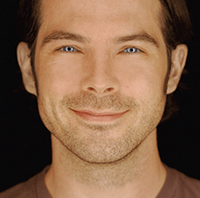VIDEOS
PRAISE
SPEAKING TOPICS
01
Immersive entertainment to power events that Surprise & Delight
There is power in group games and interactive media to bring meeting attendees together in fun and meaningful ways. Some call it attendee engagement, others leverage the concept through marketing activations, but whatever the format, immersing your attendees in your story in a tangible way creates a more memorable experience. It is said that we forget 90% of what we “learn” in a week, but when we experience something, that learning becomes more than just a fact, it becomes a memory. The key to this event design tactic is to involve attendees as active participants, not just passive observers. In today’s meetings and conferences attendees need (and WANT!) to be engaged in the meeting, both in curating the content and in immersive learning and networking opportunities. As our speaker once shared, “today’s conferences are less about talking, more talking, a cocktail party and then departing. Effective events are about memorable, rare experiences, those that can’t be had in normal life.
To achieve this level of engagement, there’s a new breed of experiences combining technology and innovative thinking. Meeting professionals need to stretch their creativity and innovation skills to stay one step ahead in the fast-changing world of immersive experiences. In his role with Two Bit Circus, Brent is part of a band of mad scientists, artists, inventors, storytellers, educators and performers who together blur the line between physical and digital to create a new world of social amusement. They bring together technology and spectacle, through a liberal use of lasers, fire, story, VR and robots to create memorable experiences. What if you’re not a mad scientist or storyteller? You may be surprised! Cultivating creativity is a practice to leverage both during the tactical stages of event planning and also in your overall career journey. Curiosity and passion for lifelong learning help to lay the foundation for pushing the boundaries of event production. How does one do this? Brent will provide practical tips (one of which, as event professionals we may not always agree with…it has to do with crashing conferences) and the “why” behind the importance of cultivating creativity.
In this session you will learn:
1. Best practices in leveraging innovation and creativity in your event design
2. Best practices in what makes immersive and interactive events successful
3. How to cultivate creativity in life and event planning
02
VR, AR, MR and the future of media & entertainment
A major trend in media is to increase the immersion of the user. After a brief trial in the 90’s, Virtual Reality (VR) is finally ready for prime time and the next step after . The tools of production, distribution, and consumption are finally capable and cost effective to bring this powerful technology to scale. When technology emerges from the lab, entertainment can be a natural first step. It acts as a safe proving ground before the solution can be applied to more sensitive and critical areas like medicine and education.
Brent will share the coming future of entertainment across virtual reality (VR), augmented reality (AR) and ultimately mixed reality (MR). MR is particularly exciting for its ability to turn players into real life video game characters. Environmental and distributed device control, AR, VR, haptic elements will be combined to create massively multiplayer, multi-role narrative adventures unlike anything we’ve seen before.
03
How the Entrepreneur With Crazy Ideas Turns Them Into Meaningful Revenue
The desire for human interaction runs strong and deep.
1. Follow Disney’s 3-step method when brainstorming for new ideas.
First, begin as a dreamer. Nothing is off limits. Fantasize, be absurd, the more outrageous the better. Next, rework the ideas you dreamed about into something more practical. “Of all the things that we had in the dreamer stage, we start to apply some filters to be able to cull that big set into something more reasonable,” said Brent. And finally, in the third step, “Take all the things that made it through the filters and determine what are we actually going to work on. What do we really care about? What do we think makes a ton of sense?” There is an art and science to the brainstorming process.
2. Move from prototype to testing your idea with people as quick as possible.
“The speed with which you can take an idea from concept to working prototype and put in the hands of a user has radically collapsed,” said Brent. With today’s technology, an entrepreneur can go from idea in the morning to working prototype in the afternoon. Ironically, Brent often finds that the things he and his team are most excited about are not the same ones that potential customers find exciting. To save time and money, “We try to engage with potential customers as fast as possible because there’s just no substitute for live feedback and engaging with your potential customers,” said Brent. By integrating rapid prototyping with immediate customer feedback–then iterating with what you learn–you can dramatically increase your pace of innovation.
3. Continuously iterate.
As an entrepreneur, your first idea will rarely be the best idea. Brent’s team came up with a game that involved a wall of buttons. You’d think there’s not much room to iterate on a simple wall of buttons, right? Wrong. “We’ve got to be on version 10 of this thing now. It slowly evolved into a 2-player game and then we were like, ‘Wow, what if we put it on spinning gears? It’ll make it harder.’ Well, that was true, but people’s fingers got caught in those gears so we had to do another version. Each time that we did it the game got better and better. The willingness to continuously iterate so that you’re constantly getting feedback is what really makes things awesome,” said Brent. Are you continuously getting feedback on your products and services then making improvements?
The Bushnell family on cultivating creativity and entrepreneurship at home and at work
Dubbed the “first family of fun” by Fast Company, the Bushnell’s are clan of entertainment entrepreneurs focused on creating the future of entertainment. Nolan Bushnell, serial entrepreneur best known for founding Atari and Chuck E Cheese, has eight children, most of whom are entrepreneurs in entertainment. In this energizing panel, a group of siblings will share details of their upbringing and how Nolan crafted an environment that encouraged creativity and entrepreneurship.
Blogs
- A high-tech arcade enters the hospitality biz—Brent Bushnell in The Hustle
- Brent Bushnell’s Two Bit Circus Named to Fast Company’s Annual List of the World’s Most Innovative Companies 2020
- A VR-powered circus is opening its first (virtual) big top in Los Angeles – Two Bit Circus, Brent Bushnell in TechCrunch
- Brent Bushnell’s Two Bit Circus to open Micro Amusement Park in L.A. this fall
- IMEX America speaker Brent Bushnell on Immersive Group Experiences
- Two Bit Circus raises $15 million to build next-generation micro-amusement parks
- Nolan and Brent Bushnell featured in USA Today talking about the future


